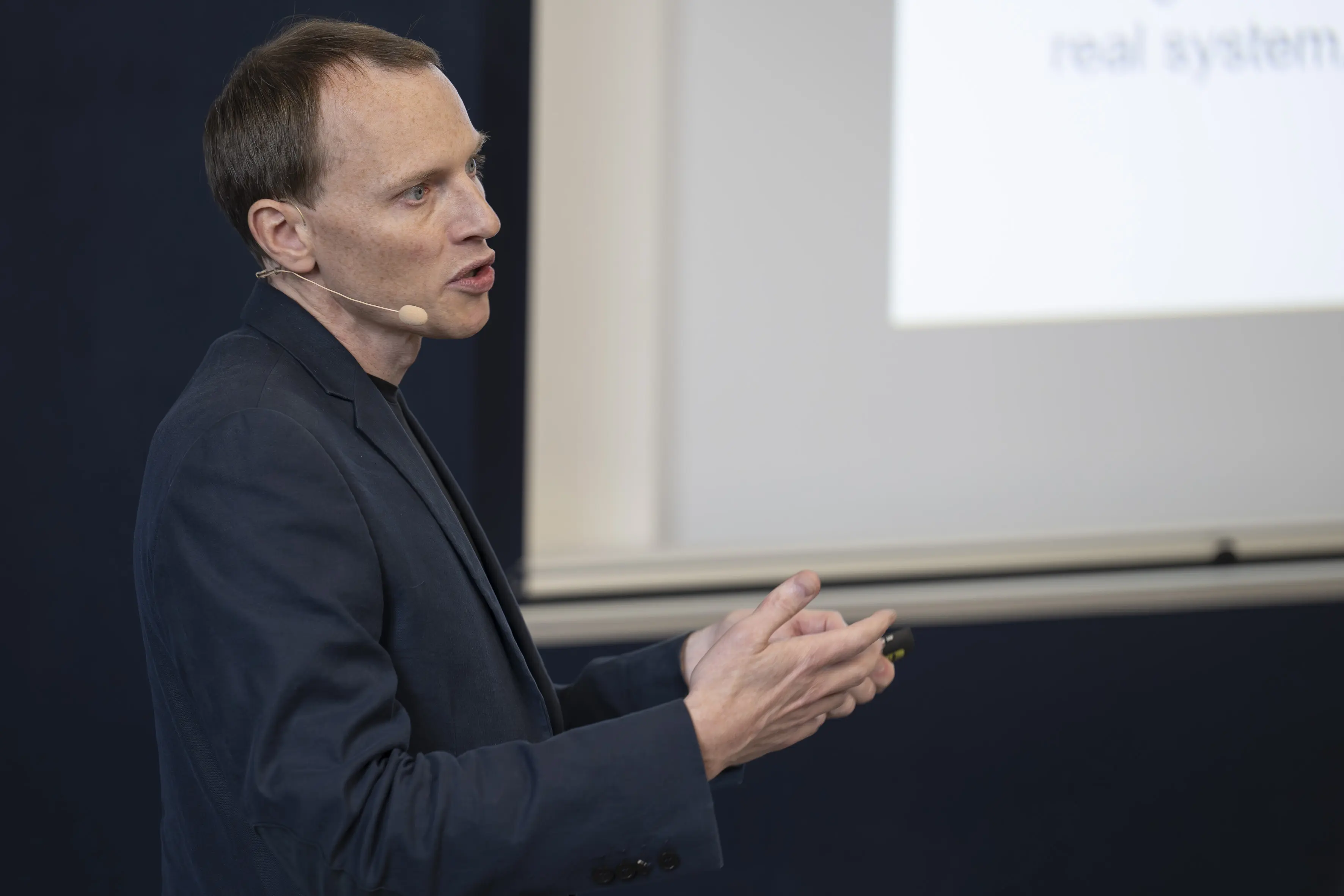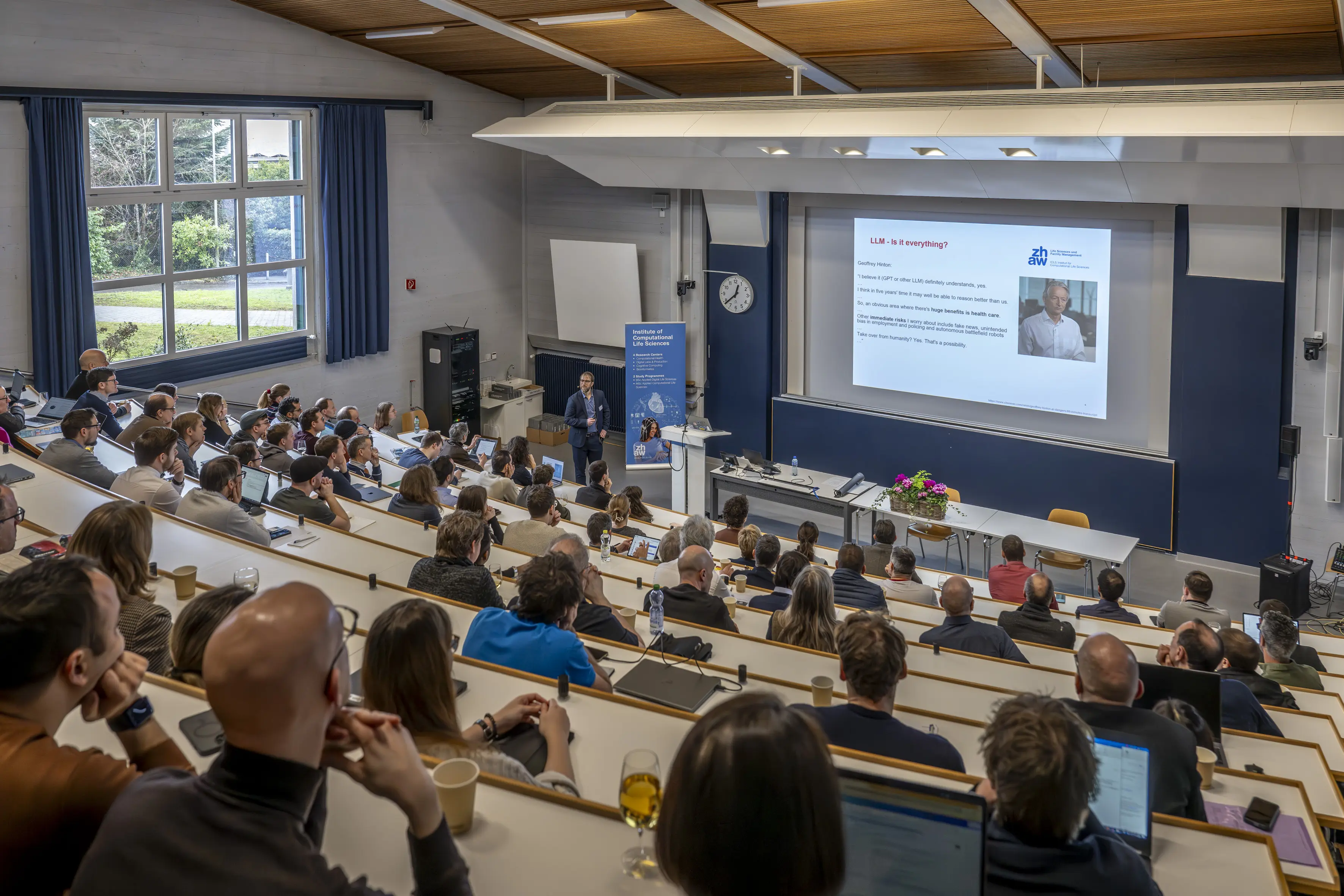Digitalization is more than just artificial intelligence
At the Computational Life Sciences Day 2025, titled "Beyond Digitalization: Automation, Simulation, and Robotics in Life Sciences", experts from the fields of artificial intelligence (AI), digitalization, and life sciences presented the latest developments and applications. A key focus of the event was digital twins and robotics.
The Institute of Computational Life Sciences (ICLS) hosted the Computational Life Sciences Day on January 8, 2025. Among the more than 150 participants were representatives from the healthcare, pharmaceutical, biotechnology, agro-food, environmental, and hardware/software development sectors. In his welcome address, Institute Director Thomas Ott emphasized that the focus on AI—particularly Large Language Models (LLMs)—was far too narrow and advocated for a broader perspective. The event’s title reflected this idea. Two topics, alongside AI, played a key role in many presentations: digital twins, meaning digital representations of real objects or processes, and robotics.
<h3>Models Require Maintenance – Through Human Intelligence</h3>
Lukas Hollenstein, Head of the Centre for <i>Digital Labs & Production</i> at ZHAW, addressed the topic of digital twins in his keynote speech <i>"Modelling Lab & Production Systems with Human and Artificial Intelligence."</i> Digital twins continue to evolve and are highly useful, for example, in predictive maintenance of production systems. He demonstrated this with a digital twin of a bioreactor, showcasing the research conducted by different teams within his focus area. He emphasized that every model requires maintenance, which in turn requires human intelligence. In addition to the bioreactor example, Lukas Hollenstein also presented projects in the food sector, such as supply chain models for cocoa mass and wheat.
<h3>Robotics, Cognitive Assistants, and Hybrid Modeling</h3>
Following the keynote speech, four industry representatives shared their perspectives. In the first talk, Thomas Zaugg from Roche discussed the challenges of robotics in an increasingly automated environment leading to intelligent laboratories. He noted that there are still too many isolated solutions that need to be connected. He also highlighted the interesting aspect that robots in laboratories can be used in different ways—either during the day in collaboration with humans or autonomously at night.
Alexander Blass from NEURA Robotics introduced cognitive robots as a key advantage for humans, explaining that, unlike other robots, these do not treat humans as machines but as people. He posed the critical question of what we actually want from AI and illustrated his point with the example of waste disposal. While generative AI only provides advice, what is really needed are intelligent assistants that actively support people everywhere and at any time—meaning they should take out the trash themselves.
With Ahmad Asraf and Bruno Olivera from Bioengineering, the discussion moved into the world of bioreactors and their digital twins. They were supported in their presentation by Muriel Zumbihl, who, as part of her ZHAW master's thesis, worked on digital twins of bioreactors and their interface to the process running within them.
In the final presentation, Angela Botros from DataHow introduced her approach to hybrid modeling. Biological processes are both too complex for pure simulations and too labor-intensive to generate enough data for data-driven machine learning. Therefore, they combine both approaches into hybrid modeling.
<h3>Presentations from the Institute and Its Students</h3>
After the coffee break and a musical interlude by the internal ICLS house band, the second part of the symposium featured presentations from the research groups of the Institute of Computational Life Sciences and their research partners. Two students (bachelor’s and master’s), a doctoral candidate, and two alumni also had the opportunity to present their work. The presented projects demonstrated the broad scope of the study programs—ranging from robotic lawnmowers and computational enzyme design to event-based cameras.
Among the research groups, Maria Anisimova from the Centre for Bioinformatics presented current research projects on biomarkers. She was joined by Julien Duc from Nexco Analytics, which offers data analysis as a service. He introduced potential collaborative projects for students.
For the Centre for Computational Health, Sebastiano Caprara from Balgrist University Hospital in Zurich explained how an agile framework is accelerating clinical research using digital twins in orthopedics.
Yulia Sandamirskaya from the Centre for Cognitive Computing examined where we currently stand in assistive robotics technology and what breakthroughs are still needed.
For the Centre for Digital Labs and Production, Robert Vorburger demonstrated how agent-based AI systems enable the integration of generative AI into laboratories and production settings.
The symposium concluded with research partner PRORES, represented by René Puls, who highlighted exciting developments in commercial spaceflight. Starlab Space will establish one of only three global science parks in Dübendorf, developing it as a commercial platform for research and production in the life sciences sector.
<h3>Contact</h3>
- Thomas Ott, Leiter Institut für Computational Life Sciences, ZHAW-Departement Life Sciences und Facility Management, 058 934 56 84, thomas.ott@zhaw.ch
- Beatrice Huber, Media Relations ZHAW-Departement Life Sciences und Facility Management, 058 934 53 66, beatrice.huber@zhaw.ch

